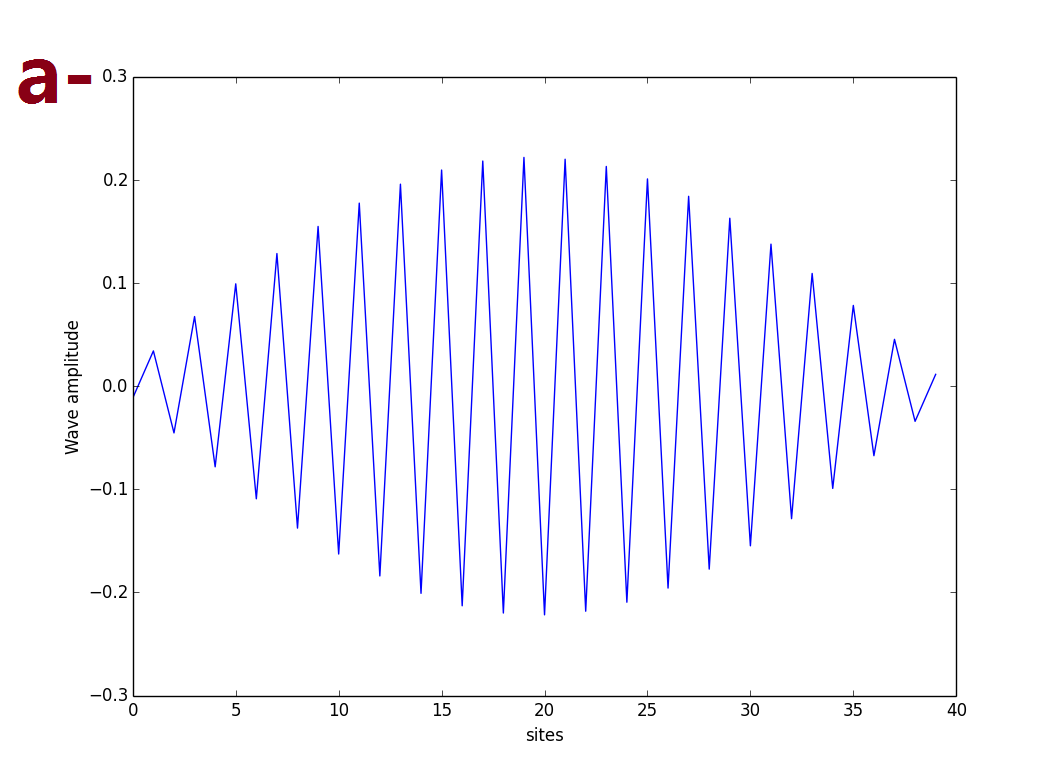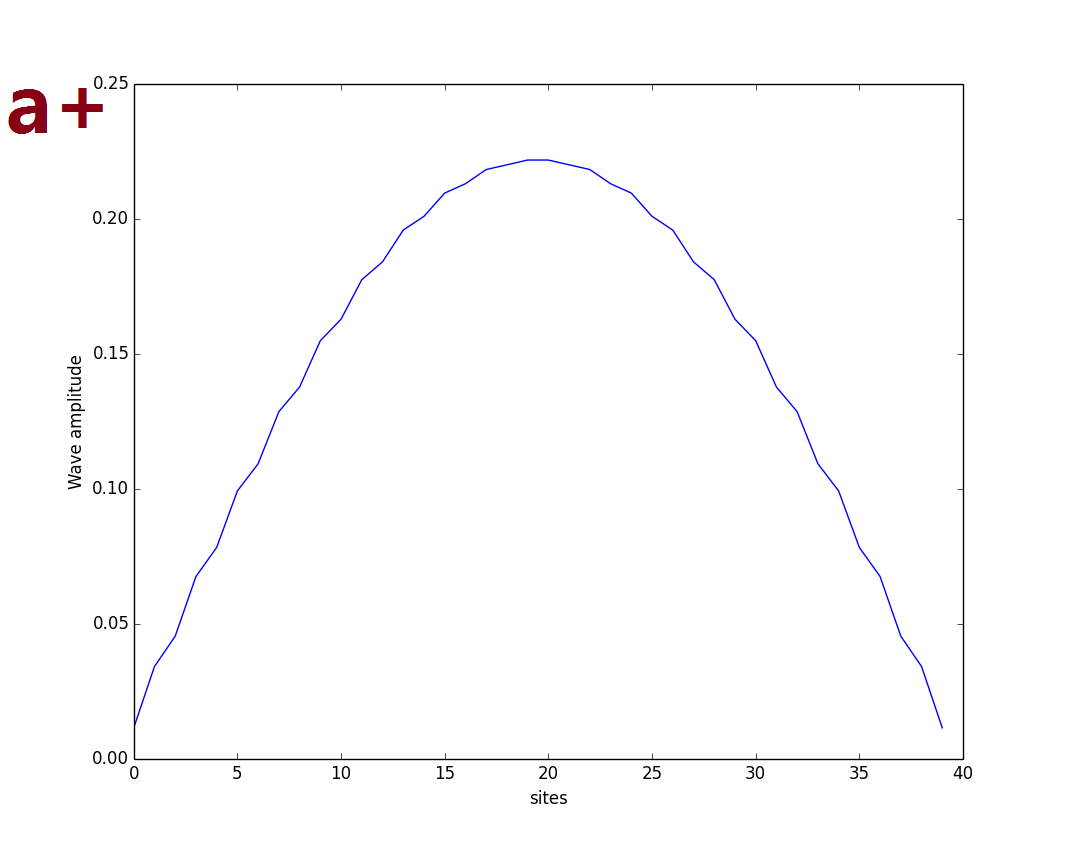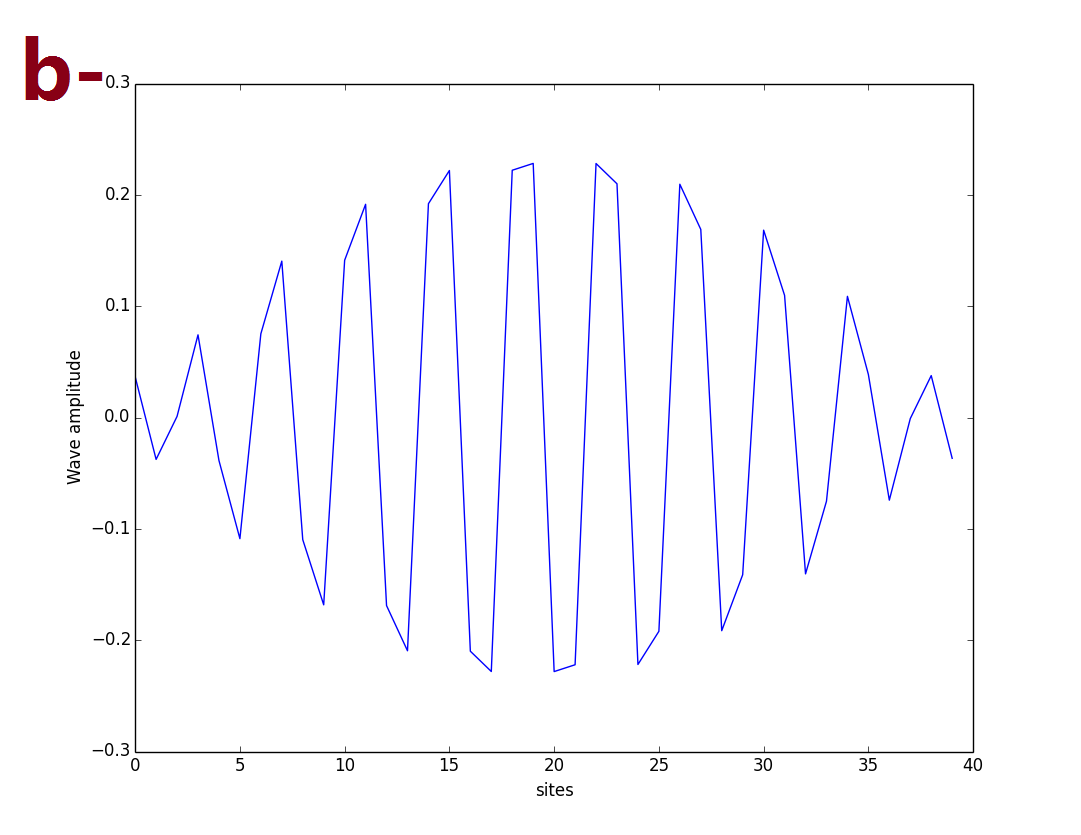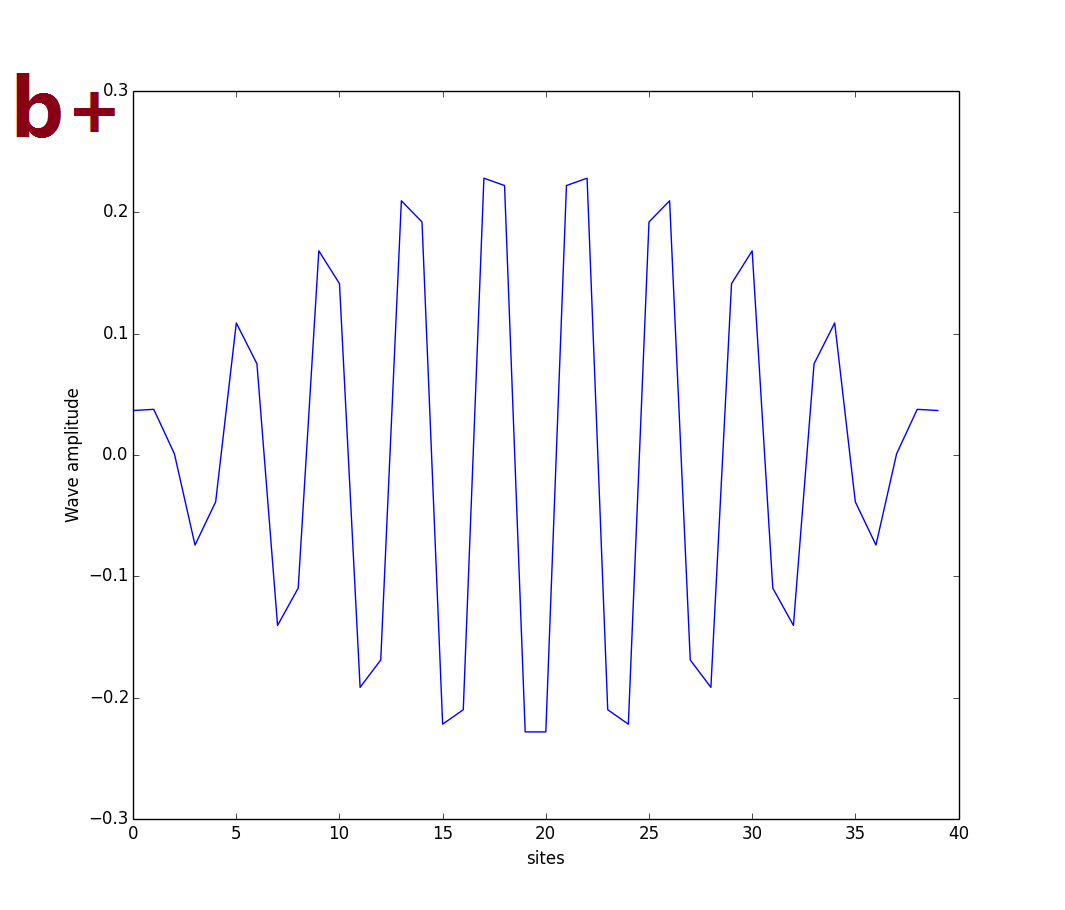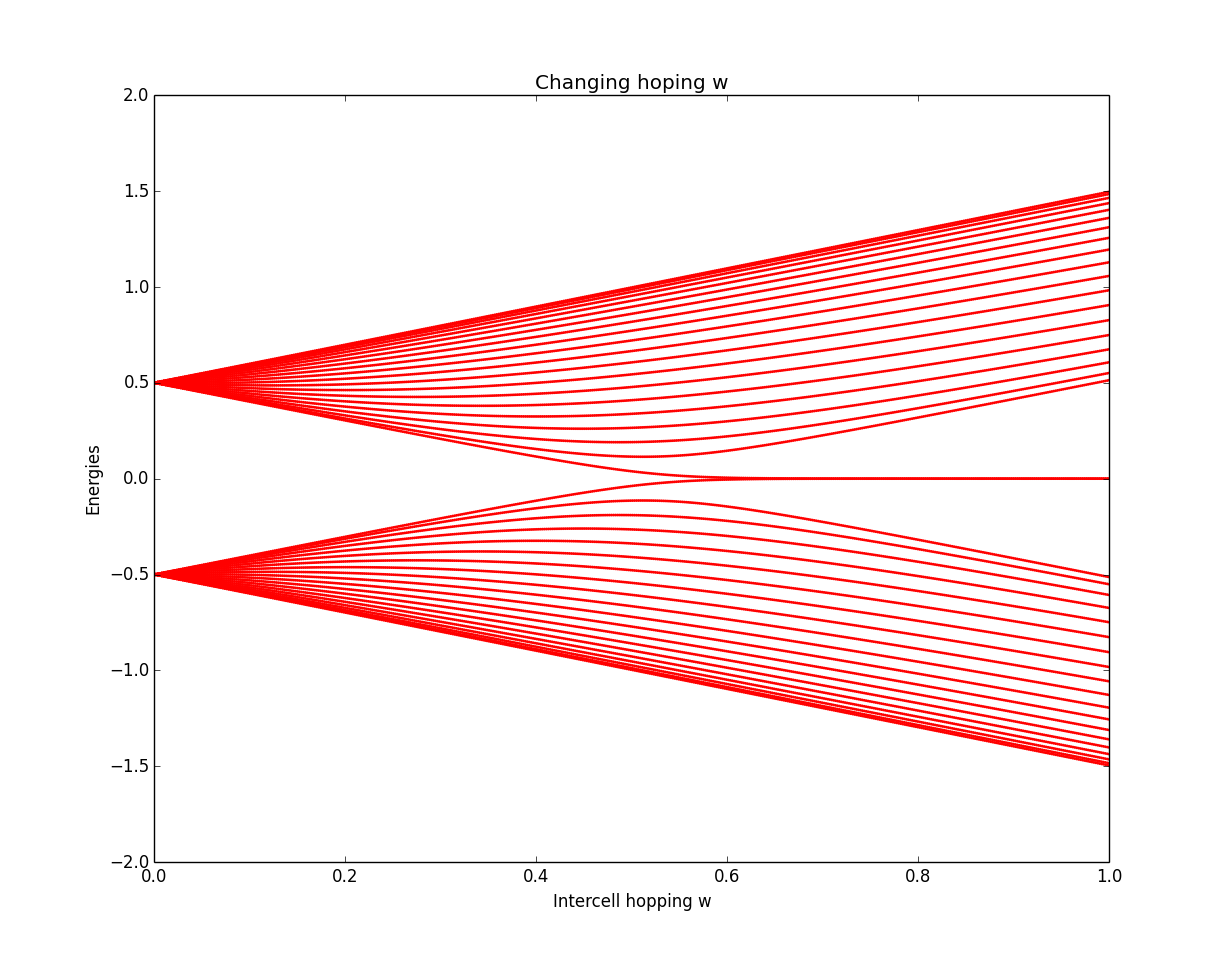Lecture 1 : 1-d SSH model¶
The Su-Schrieffer–Heeger (SSH) model¶
The simplest non-trivial topology : 1-d lattice.
Peierls instability makes the atoms dimerize.
Polyacetylene Structure:
Tight-binding method: first quantization¶
Tight-binding method: Single electron total Hamiltonian in atom chain:
with periodical potential: \(U(x+na)=U(x)\)
Assume single atom potential \(V(x)\) with Hamiltonian
and well solved eigen-value and eigen-wave-function:(consider only one state)
Do the combination
with \(\phi_n=\phi(x-x_n), x_n=na\). Define \(\Delta U(x)=U(x)-V(x)\), and substitute following equation
we get
Define: \(\langle \phi(x-ma+na)|\Delta U(x) |\phi(x)\rangle=-J(x_m-x_n)\)
We get:
Because of the Tranformation symmetry of the Hamiltonian, the resulting wavefunction \(\psi(x)\) should take Bloch form, which means we should have the solution \(a_m=e^{ikx_m}\), then, we get
Consider only the nearest-hopping interaction, define \(J_0=J(0), J=J(\pm a)\), then we have:
Second quantization¶
In the second quantization language, the expectation value of energy becomes a operator, set \(\mathscr{H}=\frac{p^2}{2m}+U(x)\), we have
with \(\psi \to \hat{\psi}=\sum\limits_n \hat{c}_n \phi_n, H_{mn}=\langle \phi|\mathscr{H}|\phi \rangle\) \(\phi_n\) is a orthonormal and complete basis in Hilbert space, like plane-waves \(e^{ikx}\) or energy eigen-states of \(H_0\), \(\mathscr{H}\) is the energy operator in single particle first quantization picture, which can only act on Hilbert space, while the second quantization energy operator \(\hat{H}\) acts on Fock space. Here, in tight-binding method, \(\phi_n\) is the wave-function of site \(n\) of the energy eigen-state \(H_0\).
Consider only the nearest interaction, we have:
\(h.c.\) means hermitian conjugation. Rewrite it in matrix form: \(\hat{H}=\sum\limits_{mn}\hat{c}_m \tilde{H}_{mn}c_n\), we have
In the case when \(t=t_n\), \(\hat{c}_n\) satisfy the Bloch condition, we can transform it into momentum space, with \(\hat{c}_n=\frac{1}{\sqrt{M}}\sum\limits_k \hat{c}_k e^{ikx_n}\),
we can easily get
which gives us the dispersion relation:
On the other hand, keep in mind that we would get \(c_n=e^{ik(n-1)a}c_1\), that is
which also gives us \(E(k)=te^{ika}+t^*e^{-ika}\).
More generally, \(t_n\) can be different from each other, for example, if they are all different up to \(4\), but have a super-periodicity with \(t_{5}=t_1\), then there will have 4 sub-bands, in the example we will consider below, we have two \(t\), \(t_1\neq t_2\), and we have two sub-bands.
If each atom have a valance electron, then the above mentioned energy band structure \(E(k)=2tcoska\) is not the stable fundamental mode, it will dimerizes to lower the total energy, that means we’ll get following coupling case:
with the Hamiltonian:
with \(M=2N\).
Review¶
In 1-d atom chain, we have got the Hamiltonian in second-quantization frame as:
\(h.c.\) means hermitian conjugation. Rewrite it in matrix form: \(\hat{H}=\sum\limits_{mn}\hat{c}_m {H}_{mn}\hat{c}_n\), we have
Energy band and topology¶
\(t_n\) can differ from each other.
- For a open chain with \(M\) atoms, we have \(t_M=0\), and this matrix will give us \(M\) eigen-values and eigen-functions.
- Possess translational invariance with \(c_{n+1}=c_1e^{ikna}\), it will be diagonalized with \(H(k)=te^{ika}+t^*e^{-ika}\).
- Staggered hopping parameters with \(t_1\neq t_2\), but have property \(c_{2n+1}=c_1e^{iknb},c_{2n+2}=c_2e^{iknb}\). We can block the Hamiltonian up in \(2\times 2\) blocks and also pair up \(c_{2n+1},c_{2n+2}\).
The Hamiltonian:
with \(M=2N\).
For a more beautiful notation, define \(\mathbf{c}_n^\dagger=(c_{n,1}^\dagger,c_{n,2}^\dagger)=(c_{2n-1}^\dagger,c_{2n}^\dagger)\), then we have
with
and
when \(|m-n|>1\), we have \(H_{mn}=0\).
For example, for 6 cells (12 sites), we have
Open chain: \(T_6=0\).
Closed chain with translational symmetry, \(T_n=T,U_n=U\), with
\[\begin{split}U=\begin{pmatrix}0&v\\v^*&0\end{pmatrix},T=\begin{pmatrix}0&0\\w&0\end{pmatrix}\end{split}\]Using three Pauli matrices
\[\begin{split}\sigma_x=\begin{pmatrix}0&1\\1&0\end{pmatrix},\sigma_y=\begin{pmatrix}0&-i\\i&0\end{pmatrix},\sigma_z=\begin{pmatrix}1&0\\0&-1\end{pmatrix}\end{split}\]
We get
Using \(\mathbf{c}_n=e^{ik(n-1)b}\mathbf{c}_1\), we have
which gives us \(H=H(k)\oplus H(k)\cdots \oplus H(k)=\oplus_{n=1}^N H(k)\) with
with
with \(w=|w|e^{i arg(w)}\).
with
with eigen-energy
and eigen-wavefunctions
with \(tan\phi=h_y/h_x\).
For example, set \(arg(v)=arg(w)=0\), we have
Can not tell the difference \(|v|-|w|=\pm\delta\).
Energy-band description is not completed, it can give us many information, but not the whole, others are hidden in the wave-function. Alternatively, recalling \(H(k)=\mathbf{h}(k)\cdot \mathbf{\sigma}\), the Hamiltonian should contain the whole information, but we have only used \(|h|\), in topological aspect, \(\mathbf{h}(k)\) will suffices.
Set \(arg(v)=0\),\(kb=[0,2\pi]\), we have two cases
- \(|w|<|v|, \mathbf{inter}<\mathbf{intra}\)
- \(|w|>|v|, \mathbf{inter}>\mathbf{intra}\)
Winding number¶
\(H(k)=\mathbf{h}(k)\cdot \mathbf{\sigma}\), \(\mathbf{h}(k)=0\) is a degenerate point with \(|v|=|w|\), two bands cross, define \(h(k)=h_x(k)+ih_y(k)\), we have
define
When
- \(|w|>|v|, \nu=1, \mathbf{inter}>\mathbf{intra}\)
- \(|w|<|v|, \nu=0, \mathbf{inter}<\mathbf{intra}\)
A example, \(N=20, M=2N=40, w=1, v=0.5\), we get eigen-energys:
Edge-states:
Chiral symmetry¶
Recalling the Hamiltonian:
Define projector operators:
and the chiral operator \(\Sigma_z=P_A-P_B\), The matrix elements of \(\Sigma_z\) vanish, \(\langle 0|c_r \Sigma c^\dagger_s|0\rangle=0\) if sites \(r\) and \(s\) are in different unit cells.
In first-quantization, we have
and
In matrix form, we have
\(\Sigma_z\) is local, it does not mix site between unit cells, and inherits the algebra from \(\sigma_z\):
Recalling
There are no onsite terms in the Hamiltonian, so we have
This is the chiral symmetry.
Note
Actually, here, \(H\) is defined in momentum space, but \(\Sigma_z\) in real space, we should write \(\tilde{H}=U^\dagger H U\) for some unitary matrix \(U\), but the property survives!
Consequences: For eigenstates \(|\psi_n\rangle\) of \(H\), we have
\(E_n\neq 0\), two orthonormal states \(|\psi_n\rangle, \Sigma_z|\psi_n\rangle\), which gives
\[\begin{split}\begin{pmatrix}\alpha^* &\beta^*\end{pmatrix}\begin{pmatrix}\alpha\\-\beta\end{pmatrix}=0\end{split}\]\[\Rightarrow |\alpha|^2=|\beta|^2\]\(E_n=0\), we particularly have \(\Sigma_z=\Sigma_zH\), \(|\psi_n\rangle\) can be eigen-states of \(H\) and \(\Sigma\) simultaneously, \(\Sigma_z|\psi_n\rangle=\pm|\psi_n\rangle\), gives \(|\psi_n\rangle=\begin{pmatrix}1 \\0\end{pmatrix}\) or \(|\psi_n\rangle=\begin{pmatrix}0 \\1\end{pmatrix}\)
Review 2¶
In the last class, we have solved 1-d atom chain with staggered hopping parameters and got the Hamiltonian:
with \(tan\phi=h_y/h_x\).
Eigen-values are \(E(k)=\pm|h(k)|\), with eigen-functions: \(|\pm\rangle=\begin{pmatrix}\pm e^{-i\phi(k)}\\ 1\end{pmatrix}\).
\(\mathbf{h}(k)\) depicted as follow:
Topological transition¶
We have already seen, for \(|w|>|v|\) or \(|w|<|v|\), we got different winding number, means there is a topological transition at \(|w|=|v|\). In the energy-band point of view, it means the gap between two energy bands closes (across each other) and reopens. There are two ways to change the winding number and get a topological transition:
- Pull the path through the origin in the \(h_x-h_y\) plane.
- Lift it out of the plane (breaking the chiral symmetry).
Case 1(a): \(v=0.5, w=0\to 1\)
Case 1(b): \(w=1, v=2.5\to 0\)
Case 2: Sublattice potential \(H_{sublattice}=u\sigma_z\). Recalling
with \(U=\begin{pmatrix}0&v\\v^*&0\end{pmatrix},U=\begin{pmatrix}0&0\\w&0\end{pmatrix}\), now \(U\) changes to \(U=\begin{pmatrix}u&v\\v^*&-u\end{pmatrix}\), and \(H(k)=\mathbf{h}(k)\cdot\mathbf{\sigma}\) with \(h_z(k)=u\).
Set \(w=1, v=1.5-cos\theta, u=sin\theta, \theta=0\to \pi\),
Case 3: Charge Pump: Using the Hamiltonian \(H=u(t)\sum\limits_{i=1}^N(-1)^{i-1}c_i^{\dagger}c_i+\sum\limits_{i=1}^N[t_0+\delta(t)(-1)^i](c_i^{\dagger}c_{i+1}+h.c.)\), with \(u(t)=u_0 sin\theta, \delta(t)=\delta_0 cos\theta\), add time variation with \(\theta=2\pi t/T\), in previous notation, \(v=t_0-\delta(t), w=t_0+\delta(t)\). set \(u=sin\theta, v=0.75-0.25cos\theta, w=0.75+0.25cos\theta\), the vector \(\vec{h(k)}\) is
The energy band evolution is
Winding number v.s. Zak phase¶
From
We have defined the winding number
From the Zak phase definition:
Recalling \(|\psi\rangle=\frac{1}{\sqrt{2}}\begin{pmatrix}\pm e^{-i\phi(k)}\\ 1\end{pmatrix}\Rightarrow\gamma=\frac{1}{{2}}\oint dk\nabla_k\phi=\pm\pi \ \textit{or}\ 0\).






